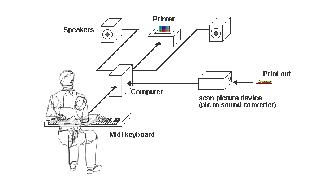


| URL: | http://netzspannung.org/database/103110/de |
| Last update: | 03.07.2003 |
| Date of print: |
 |
Illustration of installation setup |
Inhalt
Inhaltliche Beschreibung
Above all, the basic notion of this project is that music generates colour pixels on the screen and these pixels are printed on the paper, then this paper can generate music just like storing and playing a CD. In addition, people can compose and record music by marking color on the paper. In the first processing stage, people play the keyboard to generate color which creates a visualization and notation of the music. The next stage involves printing color pixels on the paper. The reason why we made this process is that we wanted the paper to be able to store the music, just like CDs and tapes.
The third part is for scanning color to regenerate/play the music. We created a box for scanning color on the paper. It will play what people previously recorded on this music paper, and people can change the instrumentation while playing the music. As I mentioned before, this part of process gives the user the ability to compose and record music with greater ease by filling the empty pixels with colors on the paper. Thus, if people have little knowledge about the process and the difference between color and music in this project, they will recognize which color represents which pitch and therefore they can draw their own color patterns instead of composing notation. Once the composing is done, it plays what you made immediately through a scanning device. People can see how the melody is produced through the color on the paper before scanning and playing. It can also be a painting tool, which is controlled by music. Users can generate patterns and simple pictures by pitch.
Kontext
Hochschule / Fachbereich
Ravensbourne College of Design and Communication
MA Interactive Digital Media
URL der Hochschule
» http://www.rave.ac.uk
Betreuer des Projekts
Prof. Karel Dudesek
Kommentar des Betreuers
The Pixel Orchestra is a three way input output sound generative project:
Not only that the sound piece
1st is stored on a colour printed paper but as well the system can interact with
2nd a scanned image and play the image like a CD or other storage media
3rd the user can draw pixels by hand on a paper sheet, by scanning in the image the computer translates it into sound.
Seminar / Kurzbeschreibung
MA Interactive Digital Media at Ravensbourne College, London, is a relatively new course, since 1 year led by Professor Karel Dudesek of Vienna, who brings experience on a wide range of activities from media arts to interactive television to virtual reality. The intention is to offer a much broader horizon for students than that of typical "multimedia courses".
The students & staff of MA IDM are involved with creating projects in interactivity, visual and audio mediums, online and networked systems and generally exploring new approaches to technology. This has been realized through the ongoing development of an MA Experimental Resource -<XR>- a studio with a philosophy to develop "space based media", both actual and virtual. What we are developing is a resource for spatial sound installation, a virtual set area, use of tracking and interactive sensing equipment, all linked to computers and software such as Max, MSP, Nato. We are inviting students to use sensors and electronics to make real-time interaction, and to think about presenting their work in a different way. In the first year it has been the introduction of Max software into the curriculum that has kick-started this progression to a new kind of work, and the creation of some exciting projects.
Zuordnung Forschungsbereich
In the current second year, students have realised projects with spatial interaction and sound, using techniques such as video tracking and surround sound positioning. The current interest both from staff and students are works that reflect upon the experience of time based, or real-time art works, and that uses processes available in the software such as Max/MSP/Jitter to make prototypes and presentations of these ideas. Time is certainly a key part of media art installations. Viewers are familiar with works that are immersive, whether by use of VR equipment or large scale projection, and are seemingly looking for works that allow themselves to be immersed in the technology. What is interested in using software that can work in real-time and interactively, is that the "time" element of the work can be played with and thus we have ideas such as the memory recorder. Previous projects and works in progress are showcased on the website at: http://www.ma.rave.ac.uk/xr/
|
|
| » http://www.ma.rave.ac.uk/pixelorchestra |
|
|